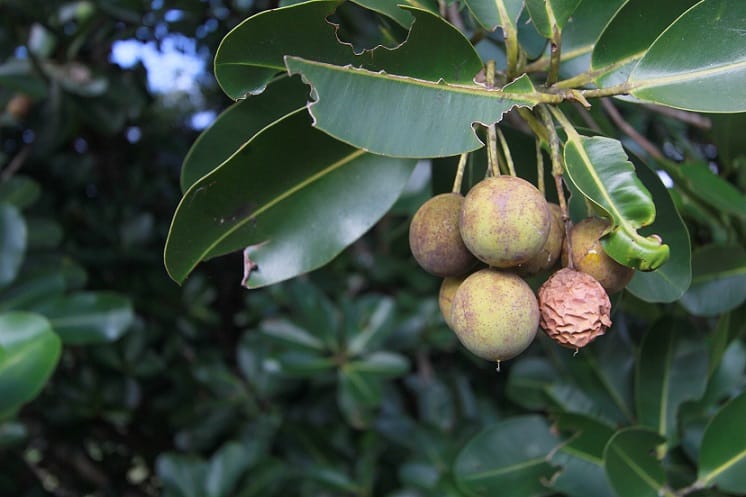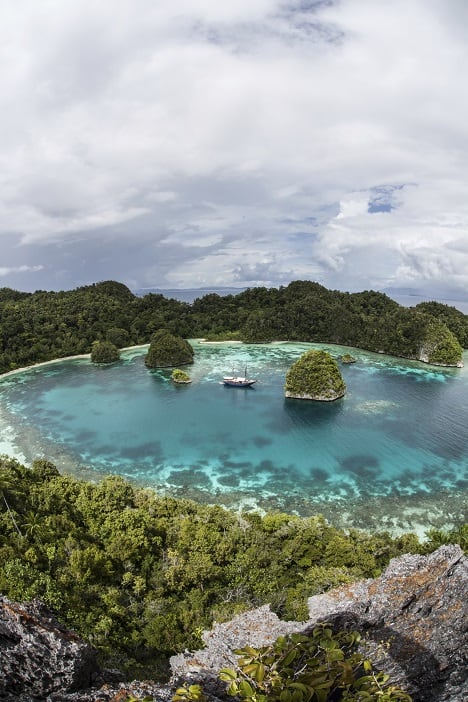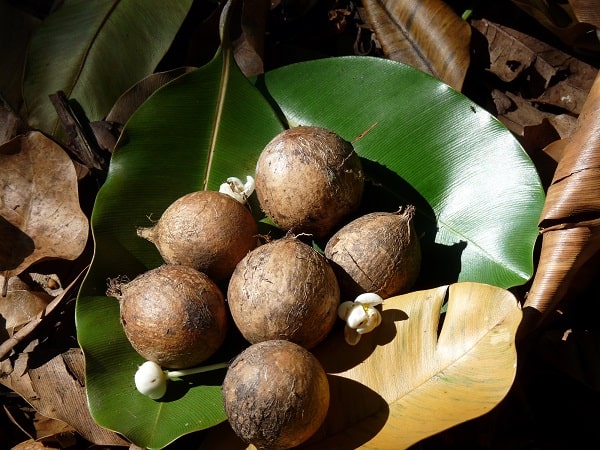 Today we will discuss an acne remedy which saved one woman’s life as she knew it during the last 100 years, and saved thousands of lives altogether during the preceding 10,000 years.
Today we will discuss an acne remedy which saved one woman’s life as she knew it during the last 100 years, and saved thousands of lives altogether during the preceding 10,000 years.
Deep in the archives of French healthcare lore is the tale of an anonymous patient with a gangrenous ulcer, admitted to hospital after any natural healing seemed hopeless. The woman’s fate was apparently sealed as doctors intended to amputate her leg to save her life.
In a desperate final measure, the wound was dressed regularly with our prospective acne topical treatment. The wound completely healed, the woman kept her leg, and the only remaining sign of this close shave was a smooth and flat scar.
This miracle treatment is a natural oil which gained popularity for acne a few years ago, called tamanu oil. For the top 10 brands for acne, read this article, but today we will discuss why tamanu oil could be miraculous for your skin.
The cure for acne: hiding on a tropical beach in Fiji?
Tamanu oil has been a wound healing, bite calming, infection killing staple for thousands of years in the South Pacific. The oil is extracted from the nut of the fruit of the ten feet tall Tamanu tree (Calophyllum inophyllum), found mostly in coastal areas with sandy, salty soil.
The tree has a few scattered outposts in East Africa and South India but its stronghold is Polynesian islands like Fiji and Tahiti. The tamanu tree’s survival method is a very easy one: the fruits drop onto the sand and are pulled into the sea by the rising tides, embarking on a long voyage until they land on the shores of another sandy-coasted island, plant themselves, and create a whole new colony of trees.
Read Annihilate Your Acne – get the ultimate diet for clear and glowing skin!
The fruits themselves have the same size and appearance as a green apricot, but are actually in the same family as the mangosteen. As the fruit ripens it drops from the tree, and the Polynesian locals eat the flesh and extract the seeds within. They then dry these seeds or kernels in the sun for two whole months, which browns the seeds and increases the content of oil inside. Finally, the seeds are either pressed by hand or expeller pressed with modern machinery, but not with modern chemicals, for real tamanu oil is always cold pressed.
Thus the Polynesian islanders have a green-tinted oil which has saved their lives countless times over. Tamanu oil is the default treatment for disinfecting wounds, and calming burns. It is constantly used to treat spider bites, mosquito bites, and snake bites (there’s over 450 species of snake in Indonesia alone).
The women use tamanu oil as a traditional beauty treatment, and it’s often stated that Polynesian women have the most beautiful complexions on earth. If true, it’s almost certainly down to their diet as well (see this article) but it’s possible that tamanu oil does contribute.
Polynesian mothers rub tamanu oil into their babies to keep their skin smooth and the tamanu tree branches are revered for containing the life force of the gods whenever they feel like making a trip to Earth. Tamanu oil is even said to relieve a sore throat simply by rubbing it topically onto your neck. Even local hospitals use tamanu oil dressings routinely in operations.
While teenagers in preindustrial England made futile attempts to clear pimples with lead-based makeup or witchcraft, the natives of Tahiti and Fiji had no idea of what acne even was. Only in the last hundred years has tamanu oil left the islands of Polynesia and only in the last ten have acne patients become excited about it.
The typical claim is that tamanu oil is a fantastic treatment for acne itself, but especially acne scars. But the full story is very different….
Why tamanu oil can calm raging acne
Tamanu oil’s powers have finally been confirmed after years in the wilderness as a folklore product. This study is exactly what we acne patients are looking for, particularly given that it analysed 5 different tamanu oils, making the results rock solid. TO1 was from Indonesia, TO2 and TO3 were from Tahiti, TO4 Fiji, and TO5 New Caledonia. While technically the same species, the different geographical origin is guaranteed to give them nutritional differences.
Firstly, scientists tested tamanu oil’s antibacterial properties, to ascertain how strong they were or if indeed whether they existed at all. This test was performed on human cells and human derived bacteria, and first up were 49 strains of bacteria implicated in skin diseases.
Vital reading: the top 6 vitamins and minerals for radiant and clear skin
The 3 gram negative bacteria strains continued to grow, but all 46 gram positives ones were halted. That’s excellent news because propionibacterium acnes, the dreaded acne bacteria that lurks in skin pores, is a gram positive bacteria. What’s better is that p.acnes itself was tested…
…and each type of tamanu oil was “highly active” against it, destroying the bacteria and inhibiting its growth.
Tamanu oil was a more potent bactericide than the antibiotic ofloxacin; TO1 was the most effective. Apparently: “these data strongly suggest that CIO (tamanu oil) could be topically used in the treatment of acne”.
A less known acne bacteria called propionibacterium granulosum was also decimated by the tamanu oil. This bacteria also feeds off oily skin and colonises human skin pores, but is present in only 100th the numbers of p.acnes. P. granulosum is nowhere close to fully understood, but while this study described its role as “feebler than that of p.acnes”, it was still deemed to be worthy of investigation and acne-prone skin usually contains far more.
Initially, the scientists discovered that tamanu oil stimulated the secretion of a bactericide called β-defensin 2, which the immune system naturally produces. That’s an intriguing power, but β-defensin 2 only strikes against gram-negative bacteria.
Further analysis revealed that the fatty acids such as linoleic acid were not responsible for killing p.acnes either. It was down to more obscure plant borne compounds in the oil, and they narrowed the list down to four: calaustralin, calophyllolide, inophyllum C, inophyllum E. These four coumarins are unique to the tamanu fruit nut, and this study had previously discovered antibacterial properties in them against gram-positive bacteria.
We have our answer, but the peptide remains interesting. What if tamanu oil stimulates another peptide which is active against gram-positive bacteria like p.acnes? A candidate could be beta-defensin 1. There’s a potential downside as well; beta-defensin 2 also has pro-inflammatory properties which could redden and inflame acne in excess.
Still, the fact that tamanu oil inhibits p.acnes cannot be denied. Five different oils from four different regions had the power.
Chapter two – wound healing madness
 Continuing with our study we have the subject of wound closure acceleration – whether any Indonesians using tamanu oil for shark attacks and tiger bites had the right idea. At stake are the prospects for old and dying pimples, including how clear your skin is at any given time and whether fresh acne scars form due to pimples not healing fast enough.
Continuing with our study we have the subject of wound closure acceleration – whether any Indonesians using tamanu oil for shark attacks and tiger bites had the right idea. At stake are the prospects for old and dying pimples, including how clear your skin is at any given time and whether fresh acne scars form due to pimples not healing fast enough.
The 5 tamanu oils were tested on a human tissue scratch wound, at concentrations of 0.01%, 0.1%, and 1%, with olive being the dilutor. Olive oil itself was tested alone as a comparison.
All 5 tamanu oils accelerated the rate of wound closure and did so much more effectively than the olive oil. TO1 and TO2 were most effective, while TO5 was slightly weaker. The scientists also tested tamanu oil’s cytotoxicity, or ability to kill healthy skin cells. For all five varieties, the concentrations required to exhibit wound healing properties were 27 to 76 times lower than the concentrations leading to cytotoxicity.
The greatness of this study was also supported by another one wound healing. This time, tamanu oil from French Polynesia (an overseas collectivity of the French republic) increased levels of collagen and glycosaminoglycans in wounds.
Why grapeseed oil could transform your skin
Collagen is the major connective tissue in human skin which is vital for laying down a matrix of new flesh in any wound imaginable, whether a leg cut, a great white shark bite, or a hacked-to-pieces pimple. Glycosaminoglycans are not fully understood (despite being an ancient molecule which originated long before the dinosaurs inherited the earth) but are vital for directing other chemicals and proteins in the wound, like a manager at a building site.
Collagen levels increased 1.1 to 1.23 fold after 4 hours, but after 24 hours they increased 1.4 fold. Glycosaminoglycans were similarly time dependent, increasing 1.75 fold in 4 hours and a massive 3.7 fold in 24 hours. Tamanu oil had similarly excellent effects on wound healing overall and even beat a topical vitamin C preparation: 14 hours to heal vs 15 hours to heal.
The explanation
Tamanu oil contains a unique feature among skincare oils: a resin section which is rich in bioactive compounds. These include calophyllolide, tamanolide, inophyllum D, inophyllum P, inophyllum C, calanolide B, tamanolide D, and much more. These resinous compounds are also the magical substances behind the antibacterial properties…
…and one of these special compounds is believed to be the collagen-booster as well. The fatty acids like linoleic acid almost certainly play no role; they’re so widespread in other plant oils that such powers would have been detected a long time ago.
Grapeseed oil can improve wound healing through other mechanisms like supplying linoleic acid, but a power to increase collagen is rare among skincare oils.
The complete acne analysis – become an expert
 POSITIVE – many natural oils have equally natural sunscreen properties, but tamanu oil seems to be particularly effective, since this study showed that 1% concentration tamanu oil could inhibit 85% of UV radiation damage to DNA.
POSITIVE – many natural oils have equally natural sunscreen properties, but tamanu oil seems to be particularly effective, since this study showed that 1% concentration tamanu oil could inhibit 85% of UV radiation damage to DNA.
The tested oil also had a sun protection factor (SPF) of 18-22, which theoretically grants you an extra 180-220 minutes in sunlight without sunburn if you normally burn after ten minutes. I wouldn’t advise taking that literally, but it’s still great. In another study olive oil and coconut oil only scored 7.549 and 7.1196 respectively.
POSITIVE – the same coumarin compound which inhibited p.acnes, called calophyllolide, has “significant anti-inflammatory properties” according to this study. Among the millions of plants on earth, tamanu tree nuts are the only one where calophyllolide occurs, or as far as our limited herbalism merchants know it is.
Raw honey – a natural secret for wiping out acne bacteria
NEUTRAL – despite the glorious defeat of p.acnes bacteria there are few amazing testimonials from acne patients. Many report that tamanu oil did nothing but moisturise their skin. There’s a few fantastic stories and a few poor ones but not enough of either to uncover the truth.
NEUTRAL – tamanu oil has an official comedogenicity score of 2 out of 5, indicating a “moderately low” chance it will clog pores. That’s below coconut oil (4) and above castor oil (1), and equal to grapeseed oil (2). Tamanu oil might clog your pores if your skin pores have a genetically small diameter.
NEUTRAL – forgetting about the unique resin section, the fatty acid composition of the average tamanu oil is as follows:
- Stearic acid: 24.58%.
- Palmitic acid: 15.86%.
- Oleic acid: 30.94%.
- Linoleic acid: 25.78%.
- Alpha-linolenic acid: 0.25%.
- Others: 2.59%.
Our ally linoleic acid and our enemy oleic acid are roughly balanced in this oil. Linoleic acid might exert its skin cell regulating, protein-strengthening properties if like many acne patients, your skin cells are especially deficient in it. Oleic acid might disrupt your skin barrier if yours is particularly weak.
The oleic acid is much lower than the irritating olive oil at 70% but the linoleic acid is much lower than the glorious grapeseed oil with 69.6%. Countries vary as well with one Tahitian tamanu oil containing 39.24% oleic acid and one Fijian oil containing 28.07%.
If you’re unlucky you might have freak reaction from an outlier tamanu oil, but olive oil and avocado oil are still much higher. The fatty acid profile is neutral for acne.
THEORETICALLY NEGATIVE – in all the archives and reports, I haven’t seen a single concrete downside of tamanu oil. It’s clearly safe in general because the Polynesians have been exploiting it for so many millennia.
The one possibility is that because of the unique resin portion of tamanu oil, rich in unique and unresearched compounds, there’s a higher chance of a freak reaction compared to usual. Ethnicities from Oceania could even be more adapted to the plants and oils from the land in which they evolved; Europeans may not succeed with tamanu oil. Luckily, both scenarios are complete speculation.
The verdict – does tamanu oil clear acne?
In Western civilisation an attempt to kill p.acnes bacteria involves a century of research, a billion dollars of funding, thousands of hardworking scientists, and millions of disappointed teenagers before an effective but painful solution is achieved.
In Polynesia you have to stroll across a sandy beach and whack a tamanu tree with a hammer. Overall, tamanu oil does live up to its storied reputation. It almost certainly won’t clear your acne and it’s guaranteed that tamanu oil won’t cure it, because p.acnes bacteria is only one piece of the puzzle. Clogged skin pores are why p.acnes bacteria thrives in the first place and an unnatural diet is why clogged skin pores appear.
However you will pile more and more pressure on your acne to give up and call it a day. Tamanu oil joins raw honey and blue light devices in the halls of antibacterial topical treatments and aloe vera and cinnamon in the barracks of the wound healing weapons.
STRATEGY ROOM
Ideally, you should apply tamanu oil when your acne is already moderately active. The antibacterial properties are effective for both soothing acne and preventing it, but the wound healing properties will remove any existing pimples extra quickly.
Unlike green tea or sea buckthorn oil (still excellent natural topical treatments), using tamanu oil isn’t a protracted six week war; it produces noticeable effects after 4 hours and even better ones after 24. The enriched skin and calmer pimples almost certainly won’t appear that quickly, but the gears of clear skin will be turning furiously behind the scenes.
It’s smartest to leave tamanu oil on overnight or all day for maximum benefit. You can rub tamanu oil into your entire face OR you can apply it locally. For local antibacterial benefits, apply to a particularly red spot and cut off the stimulation of the inflammation. For local wound healing, apply to pimples which are past their peak of angriness but nevertheless taking a stubbornly long time to heal.
The ultimate tamanu oil for acne follows the gold standard formula for any skincare oil: cold pressed and free from contaminants, just like the Polynesians have been making it for millennia. A pure tamanu oil should be green tinged, with a strong aroma that varies from nutty to reminiscent of a stock cube.
Do NOT buy a pale yellow tamanu oil, for it will have been deresinated and thus robbed of its most special compounds. A darker, richer yellow is acceptable, because cold pressed oils have natural variation too. A thick consistency is optimal.
This Pura D’or Organic Tamanu Oil fits all the requirements and gives this ancient oil the best chance at helping your acne.
Follow your natural instincts and if you successfully get in touch with your lizard brain, or maybe primitive ape brain in our case, you will know from sight and smell exactly which tamanu oil is the best.
NEXT: learn the root causes of acne, clear your skin permanently
Thanks for reading!

Hello and congratulations on your website!
I’ve seen many anecdotal evidence pointing out tamanu oil as a treatment for hyperpigmentation as well. Did you find some evidence on this subject? If yes, what oil would you recommend best in order to fade dark spots? Tamanu or Argan oil?
Thank you very much!
Greetings; I’ve never seen any evidence whatsoever and I’ve never heard these whispers of it either. It’s possible though, because there’s so many behind the scenes studies conducted which are never released. Maybe one person heard about it on the most obscure scientific website imaginable and it slowly spread from there. Or it could be purely hype, which spread from a product page spamming out any beneficial feature they could think of. The only potential benefit for hyperpigmentation is its 35% linoleic acid content, but that’s perfectly standard and wouldn’t give it an advantage over any other oils. For now, I would choose argan oil or niacin.
Hi Richard,
My 16yr old daughter suffers from Acne Scars (pockmarks) and I wanted to get your opinion on the best remedy to help her skin repair/heal. She has started applying grapeseed oil with Helichrysum Oil. Do you think mixing the Helichrysum Oil with Tamanu Oil instead of Grapeseed Oil is a better solution?
Thank you.